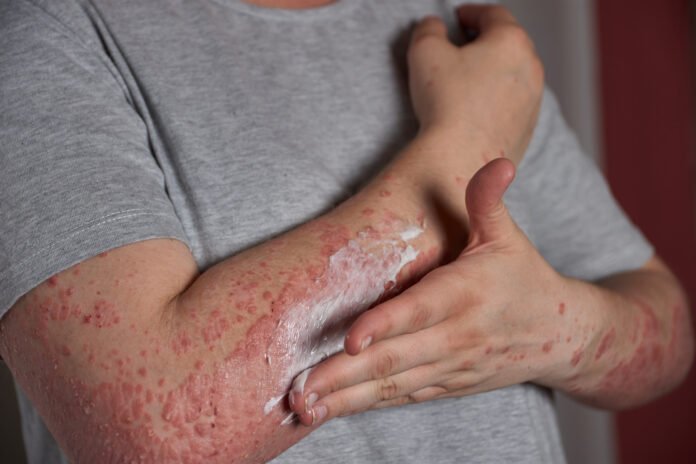Have you ever come across a situation when you experience pain due to a fever blister flare-up? Fever blister flare-up often doesn’t need a conventional treatment procedure and can be managed on its own but the pain caused by a fever blister needs certain treatment options to get relieved. Treatment procedure helps promote the healing process. Several medications and at-home remedies can help increase the recovery procedure.
Fever blisters are often known as cold sores. They usually appear in the form of sore, red, swollen wounds grouped together near your mouth or other parts of your face. Sometimes, they also appear on your gums and tongue.The sore lasts for 10 to 15 days maximum. A clear transparent fluid is released from the fever blister. This fluid makes blisters more contagious. But the virus of this infection remains contagious even when blisters are invisible. Research has shown that herpes simplex virus is the main causative agent of fever blisters. Both forms of virus i.e HSV-1 and HSV-2 affects more than 90 percent of the world’s adult population while around 70% of the population in the country has been exposed to these viruses. This estimation is 995 correct according to the world health organization.Thus its clear that fever blisters and the pain caused by the sores are common illnesses around the world.
So, it’s necessary to learn about remedies and effective treatment methods for fever blisters.
Why Do Fever Blisters Appear?
You know very well that the main causative factor for fever blisters is herpes simplex virus. The fever blisters are also known as herpes and cold sores. Sometimes the first type of heroes virus i.e HSV-12 also start attacking in your initials along with facial areas. Its symptoms often appear after the viral invasion but in some cases the symptoms do not appear right away.
In addition, viruses often lie dormant in your body and reappear at any time. The excessively stressed situation of your immune system leads to a serious outbreak that is not easy to handle.
Common Triggers for Fever Blister
Certain factors catalyze the viral activity and lead to an outbreak, including:
- Hormonal fluctuations.
- Direct sun exposure.
- Fatigue.
- Emotional trauma.
- Physical stress.
- Depression.
- Dental procedures.
- Injuries or accidents.
Certain health conditions also cause an outbreak and trigger the symptoms like pain and inflammation. These health conditions include:
- Pregnancy.
- Infection or illness in any body part.
- Old age.
- Organ transplant.
At-Home Natural Remedies for Fever Blisters
Antiviral substances, whether they are in the form of essential oils, mineral oils, or ointments can be used preferably to stop the viral activity of HSV-1. However, sometimes tropical oils and treatment options can cause skin allergies leading to irritation in your skin. Therefore, a small patch test before using these oils is recommended to avoid the side effects and complications.
In addition, essential oils shouldn’t be applied without mixing them with any carrier oil such as nuts oil or vegetable oils. One teaspoon of carrier oil is enough for half teaspoon of any essential oil. This mixing of carrier oil will lessen the consistency of pure essential oil. Always prefer disinfectant cotton swabs to apply the oil on your skin or blister. This may help you avoid contamination and allergens.
Effective At-Home Natural Remedies for fever blister include:
Tea Tree Oil
Tea tree oil is a reservoir of antiviral substances. It is often used to stop viral activity in and around the affected areas. It also catalyzes the action of antiviral elements and speeds up the healing procedure. It often helps limit plaque formation near a blister.
How to Use: Dilute it by mixing a carrier oil and dip a cotton swab in it. Apply smoothly on the fever blister and dab it on that place several times a day.
Frequency of Use: Keep continuing the application of oil till the sire is treated completely.
Oregano Oil
Oregano oil is an effective and popular source to inhibit activities of human and animal viruses such as herpes. However, the effective dose to apply on the fever blister is still under discussion.
How to Apply: After diluting the oregano oil, dip a cotton swab into oil and apply on the site several times a day.
Frequency of Use: Keep applying this oil as an ointment in the affected area till the blisters heal completely.
Ice
Fever blister also causes inflammation in the affected area. The inflammation occurs due to high blood pressure. Ice helps reduce blood pressure to treat the inflammation near sore. Ice also causes numbness around the fever blister that lessens the severity of pain. This is a type of temporary treatment that’s why it isn’t considered as effective as a treatment that not only affects the virus but also promotes healing.
How to Use: Wrap an ice cube in a thin cloth. Place the wrapped ice cube in your blister or score for 5 to 10 minutes. Direct application of ice on your skin is strictly prohibited as it can cause severe damage to your skin.
Frequency to Use: Repeat the procedure of applying an ice back on your cold sore for at least five times after up to one week or until your fever blister gets healed completely.
Apple Cider Vinegar
Apple cider vinegar is an effective remedy for fever blisters. Although there;s no scientific research that can help verify the effectiveness of ACV for treating cold sores of fever blisters. But it is true that apple cider vinegar is a rich source of anti-fungal and anti-septic substances. Its uncontrolled or unconscious use of wounds can cause serious complications as it is acidic in nature. That’s why it can cause potential damage to skin tissues. If you have a bacterial infection in the skin, you’re not allowed to use apple cider vinegar.
How to Use: Make a diluted solution of apple cider vinegar, dip a cotton ball in it and apply on the affected area. Hold it there for a few minutes and repeat the procedure several times throughout the day.
Frequency of Use: Keep the procedure repeating till the blister gets herald completely. Avoid using ACV in greater quantities as it can cause irritation and swelling in skin.
Lemon Balm
Lemon balm is another typical substance that helps kill the virus that causes a fever blister. Herpes simplex virus often observed as the causative agent and lemon balm kill that virus which is usually attached to the host cells.
How to Use: Any cream or ointment rich in lemon balm can be used for this purpose. Apply the cream on the sire or wound several times a day. After applying lemon balm, put se drops of diluted essential oil on the blister. This will speed up the healing process.
Frequency of Use: Apply lemon balm onsite until it gets healed and continue applying even a few days after complete healing of blister.
L-lysine
L-lysine is a dilute acid that may help lessen the duration of sore formation and appearance. This supplement is often recommended as a preventive treatment option. Lysine actually belongs to a group of amino acids that can inhibit the growth of fever blisters. It can also help treat fever blister outbreak. However , the limited research is not enough to include the findings authentically.
How to Use: Always follow the recommendations and instructions labeled on the package before use. According to analytical research around 1000 to 1500 milligram doses is enough for a normal person if they experience pain due to even blisters.
Frequency of Use: As it is a preventive ointment, you should apply it daily on the blister till it gets healed completely.
Zinc Therapy
Topical zinc is one of the most effective remedies for fever blisters. It is a mineral that is applied in the form of glycine and zinc oxide on cold sires. It helps shorten the duration of sores as compared to any other ointment. Recent studies showed that zinc oxide plays a vital role in preventing the outbreak of fever blisters. It makes it difficult for the herpes simplex virus to enter the cells and tissues.
How to Use: Studies suggest that taking zinc supplements like zinc sulfate in a recommended quantity for a certain period of time can help reduce the frequency of fever blister outbreaks. A controlled experiment concluded that people who took 20 mg of zinc supplements twice a day regularly for two consecutive months, were observed with complete recovery from fever blisters and cold sores. But it is important to keep in mind that I always prefer zinc oxide for topical use. It will be applied three to four times a day for maximum three months consecutively.
Frequency of Use: Zinc sulfate and zinc oxide work as best preventive measures. Apply zinc oxide cream on the sides continuously until the spurs get healed completely.
Licorice Extract
This is a root that is becoming the most reliable source to treat fever blisters.
Several studies have found that licorice has an exceptional property of antiherpetic activity, which makes it the most suitable remedy for treating cold sores and fever blisters. However, detailed information about its effect on human attacking viruses is still needed.
How to Use: Apply a diluted solution of licorice extract with your finger tips or cotton swab. You can also take it in the form of pills, crushed into a firm paste prepared by mixing powder with coconut oil. Apply this paste on your sores. If you want to take licorice root orally, talk to your doctor. Because prescribed use of oral licorice extract can cause unintended complications.
Frequency of Use: Apply the paste of licorice extract regularly twice a day on your affected area until your wound or blister gets healed.
Witch Hazel
Hazel is considered the extraordinary way to fight against herpes simplex virus. It not only helps reduce inflammation around the sore but also dries to the area which leads to healing if sore or fever blisters.
How to Use: Thayer’s Organic is a popular type of witch hazel. It is easily available. Apply it on your skin directly with a moistened cotton swab. Avoid rubbing it on your skin. Just hold on the wound and press lightly.
Frequency of Use: Continue applying witch hazel on your blisters until your skin heals completely.
Risks and Limitations
In some cases or situations, the above mentioned home remedies can be proved harmful for you. For example, applying such organic or home made ointments or essential oils is strictly prohibited for the women who are nursing or pregnant. Essential oils are not suitable or safe fir older adults and children.
- Always try a small patch test to check for any reaction occurring in your skin after applying these remedial substances. If applying any of these cream or oil causes irritation in your skin, discontinue the use immediately. In case of worsening outbreaks, stop using any mentioned home remedy. Use a small amount of ointment at the start.
- Avoid taking oral treatment for treating fever blisters but if it becomes necessary, talk to your doctor beforehand. Because such supplements can cause severe side effects when interacting with other medications.
Prevention and Management
Medical researchers are still striving to formulate a vaccine or drug to treat or prevent the HSV-1 and HSV-2 virus. But till the date they can’t. However, you can adopt some ways to keep your outbreaks to a minimum limit and reduce the frequency as well. Remember, a healthy body can fight against every infection. So the first requirement is the maintenance of your physical and mental health. Therefore, the following tips can help you prevent outbreaks of fever blisters!
- Start the treatment soon after experiencing the first symptom of a fever blister.
- Take antiviral medications regularly to inhibit the growth of causative agents i.e. herpes virus.
- Follow your doctor’s instructions strictly to stay healthy and improve your immunity.
- Practice more and more self-care approaches and strategies so that you may reduce stress from your life.
In addition, a healthy immune system, balanced diet and regular physical activity can also help you treat fever, bristle and outbreak. Limiting alcohol, sweetened beverages, spices, salt and red meat can help improve your immunity.
Conclusion
Fever blisters, cold sores and its outbreaks often appear as a result of low immunity and poor nutrition. Fever blisters also lead to more serious health conditions that damage your overall health. Certain autoimmune diseases, severe burns, eczema, cancer, and HIV are also considered as leading causes of fever blisters.
However, the speed can be treated at home by simple remedies. If your fever blister doesn’t heal and gets worse, talk to your doctor. They will prescribe some antiviral medications to treat it and prevent an outbreak.







